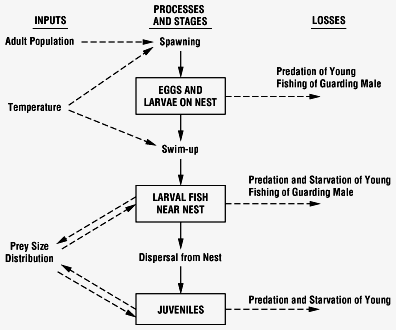


This schematic diagram shows the inputs influencing the processes and
life stages represented in the individual-based model for young smallmouth bass and the
source of losses from each of these life stages due to natural causes and
fishing.

How can models be developed to enhance decision making in fish population management?

The individual-based population model for smallmouth bass is part of Oak Ridge National Laboratory's Program on Compensatory Mechanisms in Fish Populations.
The model, tested on 10 lakes in Ontario, Canada, showed that by varying the opening date of the fishing season, it is possible to explore the results of increasing and decreasing the degree of overlap between the spawning and nest-guarding period and the exploitation of guarding male smallmouth bass by fishing.
The degree of overlap will influence the survival and subsequent growth of guarding males and the young-of-year, possibly in a density-dependent or compensatory manner.

DeAngelis, D. L., B. J. Shuter, M. S. Ridgeway, P. Blanchfield, T. Friesen, and G. E. Morgan. 1991. Modeling early life-history stages of smallmouth bass in Ontario lakes. Transaction of the American Fisheries Society, September 9-11, 1991.
Integrated Assessment Briefs. 1995. ORNL/M-4227. Oak Ridge National Laboratory, Oak Ridge, TN.